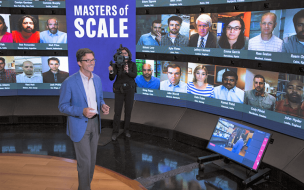But a dearth of talent has put pressure on companies and higher education to equip graduates and staff with the right skills. Tech is helping to close the gulf.
The explosion of online learning provides a digital route for future business leaders to develop data analysis skills quickly and without investing in a traditional degree.
EdX, one of a welter of online course providers that are pioneering Moocs, or massive open online courses, is bridging the data analytics skills gap. SAS, a business analytics company, says 77% of big data roles are hard to fill. “Online learning platforms are great resources to help learners fill educational gaps and develop new skills,” says Nancy Moss, director of communications at edX.
She adds that students often enrol in online courses to help advance their careers.
More than 880,000 online users have signed up for edX data analytics courses, which are developed with the likes of Harvard and MIT, two leading US universities.
Voracious demand from number crunchers means online platforms are willing to compete for students with the likes of IE Business School and NYU Stern, among the top schools offering master’s degrees in analytics. “They are looking for convenient, efficient and effective ways to learn,” says Julia Stiglitz, head of business development at Coursera, the biggest platform.
A data science course offered by Johns Hopkins University on Coursera’s site is one of the most popular among its around 13 million users.
This growth in provision is spurred by the job seekers who are eager to tap into a sea of data opportunities. Consultancy firm McKinsey puts the shortage of managers and analysts with data analytics talents at 1.5 million. “People are hungry for data science skills,” says Julia.
The global big data technology and services market is expected to hit $23.8 billion in 2016, a near four-fold increase from 2011, according to market research group IDC. Because executives must lead a change of culture, even among senior managers, analytics skills are becoming essential. “We’re seeing very strong demand,” says Yehuda Bassok, chair of the Department of Data Sciences and Operations at USC Marshall School of Business.
Michael Goul, chair of the Department of Information Systems at W. P. Carey School of Business, says whole business models are now based on predictive analytics.
“One innovation or achievement gained through analytics spawns a host of new experimentation and analysis,” he says. “Success begets more interest, investment and project ideas.”
Companies that don’t adapt risk being left in the dust by their competition. “Firms need to have an enterprise strategy for the use of data across functions,” Dustin Pusch, director of business analytics at George Washington School of Business, says.
Business schools may be late to the big data party. “Universities struggle to find staff to teach these subjects as the skills are scarce and lecturers expensive to hire,” says Mike Feerick, founder and CEO of ALISON, a leading online learning provider.
More than 50,000 users have enrolled in analytics and statistics courses on ALISON. The most popular single program across its entire portfolio is a diploma in statistics.
Bricks-and-mortar universities are turning to platforms like ALISON to gain a digital edge. “The future is going to be hybrid,” says Peter Zemsky, dean for strategic initiatives and innovation at international business school INSEAD.
Like many of her counterparts, Julia at Coursera is adamant that Moocs are key to solving the data analysis supply crunch. She points out that many of Coursera’s course takers are already in the workforce. “To satisfy the demand,” she says, “therefore means going beyond the traditional walls of higher education”.
RECAPTHA :
f2
a9
ae
80








